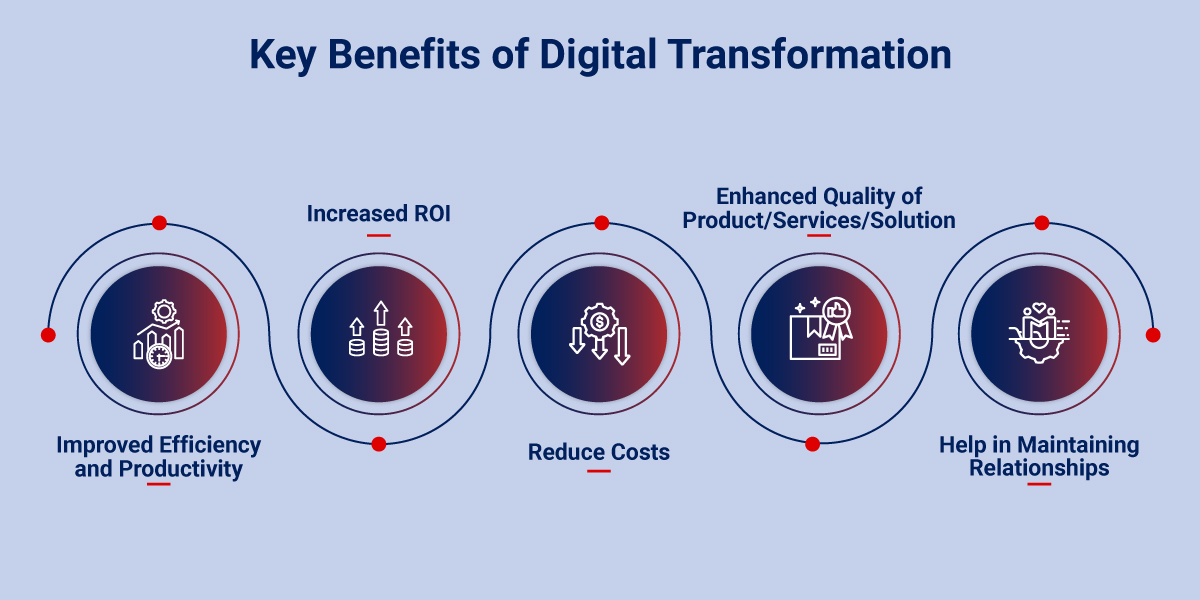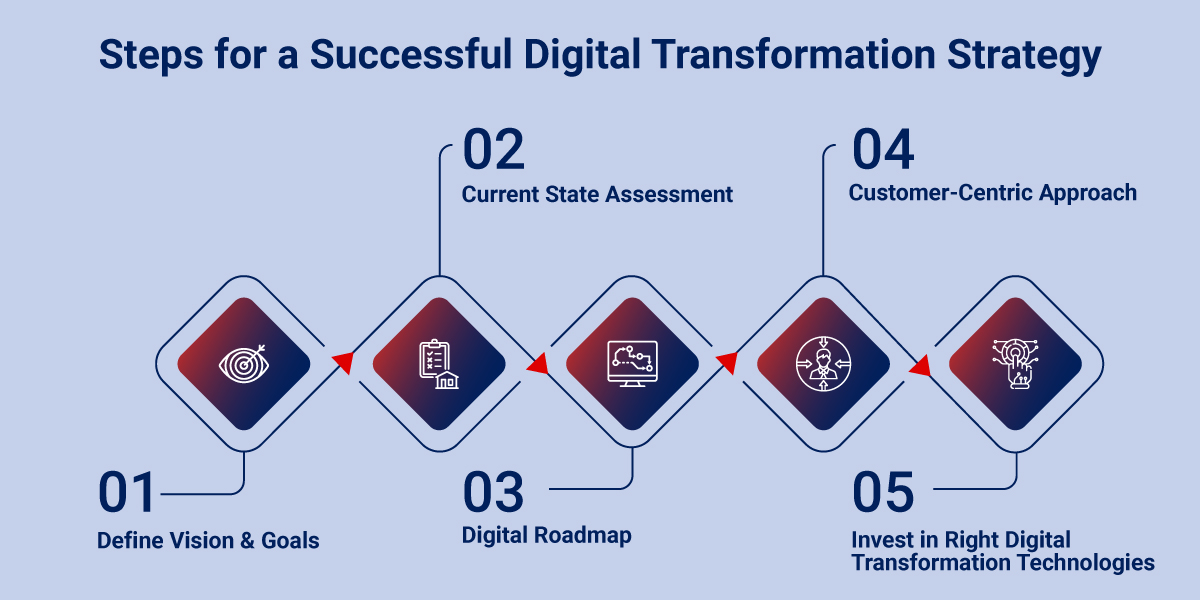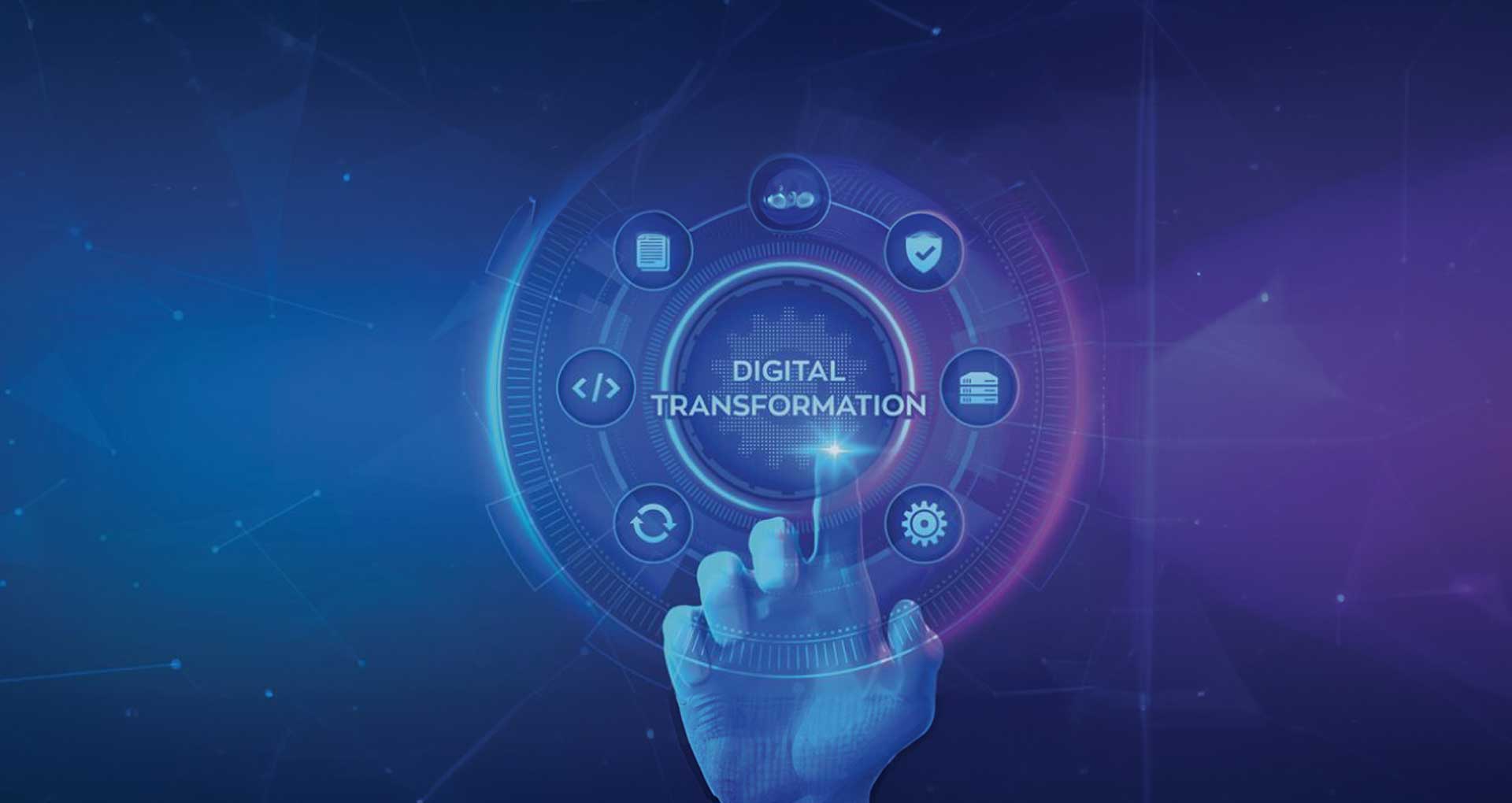In today’s world, industries focus on being more flexible and taking initiatives to unlock innovative ways to operate and compete while staying relevant in a constantly evolving environment. This includes keeping up with fluctuating market demands and advancing technologies over time. Here, digital transformation undoubtedly becomes important to promote work flexibility, encourage new ideas, and foster forward initiatives. A growing number of companies are actively investing in digital transformation. Recent research reveals that global spending on digital transformation is expected to hit $3.4 trillion by 2026[1].
However, even after investing in Digital Transformation (DX) initiatives, businesses often struggle to get the full potential of digital tools and solutions due to a lack of a guide to digital transformation strategy to execution.
Our in-depth, step-by-step digital transformation guide explores key areas, advantages, use cases across industries, vital steps to create a successful DX strategy, along with digital transformation challenges and solutions to address them.
4 Key Areas of Digital Transformation
If you are a business eager to achieve successful digital transformation, here are four key areas you should consider. These four areas are the breakdown of the range of processes and strategies included in the digital transformation process. Each of these also guides you toward identifying which aspect of your business needs transformation the most.
Customer Experience (CX): In this digital era, customers expect seamless and personalized experiences on all touchpoints. As a business, you need to employ technologies and strategies that internally understand customer expectations, anticipate their needs, and provide them with the products and services they want. Thus, in your digital business transformation journey, you can involve tools like customer relationship management software, artificial intelligence (AI), and data analytics.
Operational Process Transformation: This is the core aspect of digital transformation and refers to strategically restructuring and optimizing interconnected business operations to enhance productivity and efficiency. Moreover, it also involves reimagining modernized forms of operations by incorporating cutting-edge technologies. This can include the automation of tasks, cloud-based solutions, and the implementation of digital workflow management software.
Business Model Transformation: There may be cases where your business needs a complete overhaul of its business model. In this scenario, you may need to focus on developing new products or services or finding new ways to deliver existing ones.
Organizational Culture and Change Management: It’s important to understand that digital transformation includes not only the integration of technology but also people. Your business may need to transform its culture and ways of working to adopt digital changes in the business domain seamlessly.
Top 5 Advantages of Digital Transformation
Businesses engaging with DX initiatives allow themselves to cover all factors of improvement, such as costs, quality, time-to-market, etc. In today’s evolving business landscape, digital transformation is no longer a luxury but more a strategic imperative and necessity. Leveraging digital technologies helps improve processes, competencies, and business models.
In this section, we will explore in detail the benefits of digital transformation in business.

- Improved Efficiency and Productivity: Traditional methods of conducting tasks or activities require more human interaction and consume valuable employee time. However, with a proper digital transformation strategy, integrating the right technologies like Machine Learning, Artificial Intelligence, the Internet of Things, ERP, and others can help automate repetitive, manual tasks, which in turn can lead to significant improvements. This enables companies to achieve greater operational efficiency, improved accuracy, and increased scalability. It also includes integrating a digital workflow management system to ensure smoother and faster completion of tasks, track of progress, etc.
- Increased ROI: Investing in emerging digital technologies and embracing next-gen tech capabilities can lead to significant returns on investment in multiple forms. Similarly, through tech-enabled operational efficiency, businesses can reduce their costs with data-driven decisions. Digital transformation opens up new revenue streams by enabling businesses to offer new products or services, tap into new markets, and cater personalized customer experiences to sustain business competition and attract potential customers.
- Reduce Costs: One of the core benefits of digital transformation in business is that it encourages organizations and companies to be more calculated toward spending and saving on operational costs. Digital transformation success can lead to significant cost savings for businesses. For instance, cloud computing in digital transformation can reduce IT infrastructure costs, IoT-based predictive maintenance reduces downtime and repair costs while extending the lifespan of equipment, and the creation of online training modules and virtual onboarding programs helps in reducing in-person training sessions, travel expenses, and printed materials, among others.
- Improved Quality of Product/Services/Solution: Digital transformation tools can enhance the quality of your offerings. For example, data analytics can provide insights to improve your products or services based on customer feedback, machine learning personalizes recommendations (e.g., suggesting the right set of software updates), and digital platforms capture real-time feedback for continuous improvement (e.g., learning from customer reviews).
- Help in Maintaining Relationships: Digital transformation technologies can enhance customer engagement and foster stronger relationships with other involved entities. For example, social media allows businesses to interact with customers on a more personal level, and CRM systems strengthen relationships with suppliers by streamlining communication and collaboration. Project management platforms enhance collaboration and promote instant information sharing across internal teams, departments, and even external partners. Digital learning tools empower employees with continuous development opportunities, fostering a more engaged and knowledgeable workforce.
Digital Transformation Use Cases Across Industries
Enterprises across industries are becoming increasingly interested in integrating cutting-edge technologies such as data analytics, AI/ML, and IoT for their ability to operate smartly and grow faster. However, businesses constantly evolve as a result of varying requirements from the clients as well as market forces. Therefore, how digital transformation technologies are utilized will be indicative of the accomplishment of this journey.
Here are powerful digital transformation use cases that provide helpful ideas for organizations dealing with DX initiatives.
- Retail: The role of digital transformation in retail is constantly rising, as evidenced by giant companies such as Amazon. In addition to reshaping and enabling top retailers’, digital transformation technologies are making it possible for traditional physical stores to utilize in-store kiosks and AR applications so as to enhance client experience when shopping from them. Inventory management systems which are AI-driven are crucial in reducing overstocking as well as enhancing visibility throughout the logistics operations.
- Manufacturing: Digital transformation in manufacturing and production sector widely involves the usage of IoT technologies. Businesses are taking the bold step of embracing the power of predictive maintenance to reduce downtime and increase efficiency. Big data and advanced analytics permit the production enterprise leverage massive datasets from sensors, production lines, and customers to make data-driven decisions for the future. These advancements are further enabled by a comprehensive digital manufacturing solution, which integrates cutting-edge technologies to optimize processes and drive efficiency.
- Financial Services: Legacy financial services providers are adopting cloud solutions to enhance scalability and agility and improve security and compliance. Digital solutions such as AI-driven chatbot robo-advisors allow financial services to offer personalized advice and automated tasks. Today, digital transformation in finance opens up tremendous opportunities for various startups. For instance, financial technology ventures like Revolut, offering digital banking services for customers that are faster, affordable, and easier to operate than traditional methods. Want to know more about How DX is transforming the banking industry? Read our detailed blog about Digital Transformation in Banking.
- Healthcare: Digital transformation is revolutionizing healthcare, from electronic health records to telemedicine. With the integration of the latest digital solutions, nowadays, healthcare services providers are catering easier access to medical consultations to patients from home/any other location. Wearable devices and remote monitoring, such as tele-health too ensure patient overall well-being.
- Insurance: From amongst the list of industries, digital transformation in insurance sector offers benefits in multiple and amazing forms. The correct use of AI and machine learning fosters faster and more accurate claim processes, and wearable data can personalize policies.
Key Steps to Create a Successful Digital Transformation Strategy
Creating a digital transformation strategy ensures an impactful journey of integrating digitalization with measurable efforts toward achieving goals. In this guide to digital transformation, we explore key steps and best practices for developing a successful DX strategy in detail:

1. Define Vision & Goals
- Identify Core Needs: Recognize the primary challenges or opportunities across the operations, such as customer satisfaction, inefficiency in workflow, or lack of innovation and connectivity.
- Set SMART Goals: Take steps to pre-define Specific, Measurable, Achievable, Relevant, and Time-bound (SMART) objectives, e.g., “Increase customer satisfaction by 15% within a year.”
- Focus on Outcomes: Define the desired outcomes of your digital transformation success, for example, in terms of increasing revenue, improving efficiency, or gaining a competitive edge.
- Align with Business Strategy: Take time to ensure that your digital transformation vision and goals directly align with your overall business strategy.
2. Current State Assessment
- Technology Audit: Evaluate and pinpoint existing IT infrastructure, systems and processes to list the areas that need improvement, such as outdated systems or processes, or security vulnerabilities.
- Process Mapping: Analyze current business processes to identify inefficiencies, bottlenecks, and areas suitable for automation or optimization.
- Culture Evaluation: Determine the readiness of company culture for adaptability to new technologies and willingness to embrace change. Also, identify areas for cultural shifts.
- Skills Gap Analysis: Evaluate the current skills of the workforce to identify any gaps that are necessary to fill in case to achieve digital transformation success.
3. Digital Roadmap
- Prioritize Initiatives: Make digital transformation initiatives a top priority based on their potential impact and feasibility on business operations.
- Phased Approach: Break down the digital transformation into smaller and achievable phases to manage complexity and ensure continuous progress.
- Resource Allocation: Allocate resources such as budget, personnel, and more, based on the priorities outlined in the roadmap.
- Communication Plan: Develop a communication and collaboration plan to keep stakeholders informed about the digital transformation journey, its goals, and potential changes.
4. Customer-Centric Approach
- Customer Journey Mapping: Map the customer journey across all touchpoints to identify areas for enhancing the experience through digital tools.
- Personalization: Leverage digital tools to personalize customer interactions, recommendations, and marketing messages.
- Omnichannel Experience: Create a seamless customer experience across all channels (online, mobile, in-store) through digital integration.
- Customer Feedback Integration: Establish mechanisms to collect and analyze customer feedback continuously to improve digital offerings and customer experience.
5. Invest in Right Digital Transformation Technologies
- Needs-Based Selection: Choose technologies based on specific needs and goals identified in your vision and roadmap to avoid getting caught up in trends.
- Scalability and Flexibility: Invest in technologies that can scale with your business and adapt to evolving needs and future growth.
- Security and Compliance: Ensure chosen technologies meet security and compliance requirements to protect sensitive data and ensure responsible use.
How to Measure Digital Transformation Success?
The digital transformation journey includes complex efforts, cross-function activities, interconnected operations, and sophisticated usage of technologies, making it difficult for stakeholders to measure digital transformation success. It’s crucial to consider all projects under digital transformation as a whole – first, small pilot projects that drive instant results and larger projects that will offer long-term benefits.
Here below, we have mentioned various metrics that help you measure the success of digital transformation:
- Financial growth: Analyze the positive impact of digital transformation in the financial area of business with aspects like Revenue Growth, Customer Churn Reduction, New Customer Acquisition, reduction in time to market, and Cost Savings.
- Operational efficiency: Metrics like productivity level, working hours, and employee satisfaction rates help reflect the efficiency gained from digital transformation initiatives.
- Transformation scope: Build and rely on a maturity model to keep an eye on the organization’s progress in adopting multiple technologies like cloud, AI, and machine learning across the business units.
- Technology adoption & usage rate: Create segmentation for the adoption and usage of tech-enabled solutions based on roles, demographics, departments, and other factors.
- Reliability and availability: In order to ensure higher reliability and availability, metrics like uptime, total time of failures, and mean time to resolve issues should be used.
- Sustainability: Energy-efficient hardware and software, wastage reduction, renewable energy adoption, and energy saving are a few metrics that help you determine the sustainability achieved through digital transformation.
Digital Transformation Challenges and Their Solutions
1. Cultural Resistance to Change
Digital transformation involves embracing changes and upgrades within the organizational culture. However, the workforce may be resistant to adopting technological changes or may not feel confident in getting started with brand new practices.
Solution: Before getting started with your digital transformation journey, ensure you are taking initiatives to foster a culture of innovation, continuous learning, and adaptability to change.
2. Legacy System Integration
The digital transformation process involves incorporating modern technologies and digital solutions. However, integrating legacy systems into this modernization is a really complex and daunting task.
Solution: To overcome these challenges of digital transformation, you require careful planning, step-by-step execution of integration strategies, and consideration of all metrics to ensure a smooth transition from legacy systems to modern digital platforms.
3. Data Security and Privacy Concerns
Upgrading operations and the entire workflow with digitally powered solutions/software/platforms may introduce new security vulnerabilities. This is often considered one of the top challenges of the digital transformation journey.
Solution: The first step is to prioritize cyber security right from the start. Second, implement robust security measures such as role-based access controls, encryption and more to protect critical sensitive data.
4. Measuring Success and ROI
Venturing on the journey of digital transformation is a complex procedure, but the greatest complexity lies in measuring its success. Businesses often feel a lack of expertise and experience in defining ROI.
Solution: In the above section, we have mentioned multiple metrics that help you measure the success of your digital transformation process.
Partner with Rishabh Software to Bring Digital Transformation to Your Business
Rishabh Software offers full suite of digital transformation services, including strategy consulting, process automation, cloud migration, data analytics, and more. These capabilities enable us to deliver tailored digital enterprise services and solutions that help modern businesses stay agile, scalable, and innovation-ready. Whether you need a partner for legacy application modernization, cloud app development, mobile app development, or want to improve any business operation & process, we are your one-stop digital business transformation service provider.
Our team of experts has successfully assisted numerous businesses across various industries through their transformation journeys and delivered a seamless transition with maximized ROI. Being your trusted digital transformation consultant, we help you utilize the full potential of digital technologies to grow your business abundantly in this evolving, technology-driven world.
Frequently Asked Questions
Q: What is digital transformation?
A: Simply put, digital transformation is the process of identifying improvements or opportunities in multiple areas of a business that can be enhanced with the integration of digital technologies. The incorporation of tech-based solutions, software, and platforms aims to simplify end-to-end workflows, optimize operational efficiency, and drive effective results in the form of business growth.
Q: Trends in digital transformation
A: Here are top digital transformation trends:
- Artificial intelligence and machine learning
- Automation
- Cloud computing
- Cybersecurity
- Internet of Things
- Remote Work
Footnotes:
1. https://explodingtopics.com/blog/digital-transformation-stats











 30 Min
30 Min


